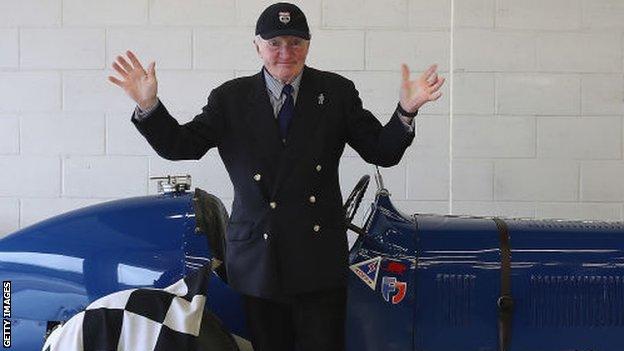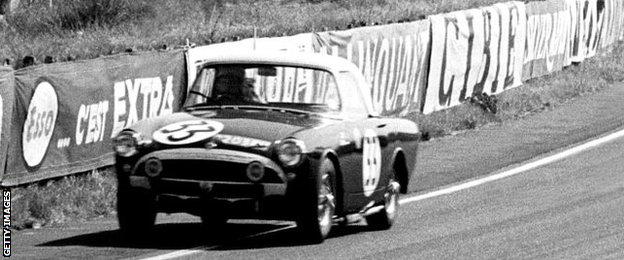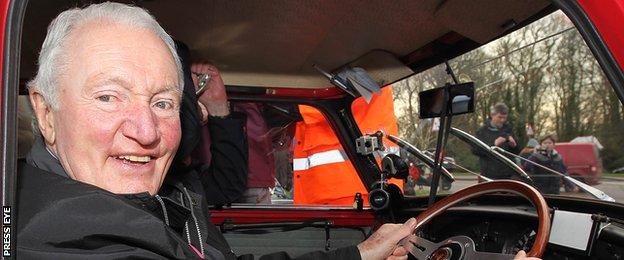Paddy Hopkirk death: Northern Ireland motorsport legend passes away aged 89
Paddy Hopkirk #PaddyHopkirk

 Paddy Hopkirk MBE, then President of the British Racing Drivers’ Club pictured during the Silverstone Classic Media Day in 2018.
Paddy Hopkirk MBE, then President of the British Racing Drivers’ Club pictured during the Silverstone Classic Media Day in 2018.
Motorsport legend Paddy Hopkirk, most famous for winning the 1964 Monte Carlo Rally, has died aged 89.
A statement released by his family on Friday afternoon said they announced his passing “with huge sadness”.
Hopkirk “passed away peacefully” at Stoke Mandeville Hospital in Buckinghamshire on Thursday, they said.
Paddy Hopkirk was among the most decorated and accomplished rally drivers that Northern Ireland has ever produced.
He is survived by his wife Jenny, their three children Katie, Patrick and William, and his six grandchildren.
“First and foremost, Paddy was a loving husband, father and grandfather, whose passing will leave a huge hole in the lives of those closest to him,” read the family’s statement.
“But Paddy also leaves an incredible legacy of motorsport and business success, while his hard work in support of the British motorsport and wider car industry continued until his final days.
“His family, friends and fans will never forget his sharp wit and wicked smile. He brought fun and joy to anyone in his company and inspired many.”
Competed in Ireland and on global stage
Born in Belfast in April 1933, he competed for many years in Ireland and on the global stage and won the famous Monte Carlo Rally in a Mini Cooper S.
Hopkirk first learned the basics of car control aged nine, when a local clergyman left him his invalid carriage in his will.
The young Hopkirk later graduated to a motorcycle with a sidecar – which was added at the insistence of his father, who felt it would be safer.
Upon attending Trinity College Dublin to study engineering, he acquired an Austin 7 ‘Chummy’ Tourer which he used to make his rally debut.
Now bitten by the car bug, Hopkirk dropped out of university to start working for Dublin’s Volkswagen assembler’s retail operation in Ballsbridge, where he purchased a string of used Volkswagen Beetles to enter competitions.
First win
Hopkirk’s first win came in 1953 at the Cairncastle Hillclimb at the wheel of a VW Beetle and he was subsequently offered a free Beetle for the first of many Circuit of Ireland appearances.
He started his winning career in professional racing and rally driving in 1955, taking a class win at that year’s Circuit of Ireland, and clinching his first Hewison Trophy, awarded to the most successful Irish rally driver of the year. He would go on to win the trophy for three consecutive years.
By this time he had graduated to a Triumph TR2 and his success with that manufacturer was noticed by the Standard Motor Company, who offered Hopkirk his first factory drive in a Standard Ten at the 1956 RAC Rally in March of that year, where he took the early lead before suffering problems later on.
Two months later he took a Standard Eight to third place in the Tulip Rally in the Netherlands – his first journey outside of Britain and Ireland.
However he lost his drive with Standard in 1958, after overdriving his car at the Alpine Rally in an effort to make up time lost due to a puncture on the Stelvio Pass, damaging the engine and forcing him to retire from the competition.
The following year he joined the Rootes Group as a works driver, initially picking up a drive in a Hillman Husky at the Safari Rally after reigning F1 World Champion Mike Hawthorn, who was originally meant to drive the car, was killed in a road accident.
Later that year he placed third overall and took a class win at the Alpine Rally in a Sunbeam Rapier, and he led the 1960 Safari Rally until his Rapier suffered a differential failure.
He took two Circuit of Ireland wins in 1961 and 1962 and another at the Alpine Rally in 1961. Whilst at Rootes Hopkirk also took part in circuit racing, winning his class in a Rapier in the touring car race supporting the 1960 British Grand Prix.
He finished third at the 1962 Monte Carlo Rally in a Sunbeam Rapier but was becoming frustrated by the Rapier’s lack of reliability, culminating in all three works cars blowing their engines within the space of a kilometre at that year’s Acropolis Rally.
 Paddy Hopkirk a Sunbeam Alpine in the 1962 Le Mans 24 Hours Joining the British Motor Corporation
Paddy Hopkirk a Sunbeam Alpine in the 1962 Le Mans 24 Hours Joining the British Motor Corporation
After being impressed by a test drive of Pat Moss’ Austin-Healey 3000, he set his mind on a move, joining the British Motor Corporation and making his debut in a 3000 at the Liège-Sofia-Liege rally in August.
In his second competition with the 3000, the RAC Rally, he finished in second despite having to complete two miles of a special stage with a shredded tyre after a puncture.
He first competed in a Mini at the 1963 Monte Carlo Rally, where he finished sixth and a year later that famous success at Monte Carlo, alongside Henry Liddon, followed.
They are the most recent all-British crew to have won the event and he also led BMC to the team win, with fellow Mini drivers Timo Makinen and Rauno Aaltonen pacing fourth and seventh.
The victory made Hopkirk a household name – he received telegrams from the then UK Prime Minister Alec Douglas-Home and the Beatles, was given the Freedom of the City of Belfast, and appeared along with his Mini on Sunday Night at the London Palladium.
 Paddy Hopkirk celebrating the 50th anniversary of his famous 1964 Monte Carlo win at Stormont
Paddy Hopkirk celebrating the 50th anniversary of his famous 1964 Monte Carlo win at Stormont
He went on to steer an Austin-Healey to victory at his next international rally, the Osterreichische Alpenfahrt, later that year.
In 1965, he won a Coupe d’Argent at the Alpine Rally and came first in the 1965 and 1967 Circuit of Ireland Rally, the 1966 and 1967 Alpine Rally, and the 1967 Rally Acropolis.
Personal accolades and life-saving actions
Hopkirk was elected as a life member of the British Racing Drivers’ Club in 1967, and was also president of the Historic Rally Car Register, and a patron of disability charity WheelPower.
In 1968, at the London-Sydney Marathon, Hopkirk gallantly gave up any chance of victory on the penultimate stage to rescue the Bianchi-Ogier team then in the lead, whose Citroen DS had just collided head-on with another car on a road supposedly closed to traffic.
Hopkirk and his team-mate Tony Nash managed to pull out occupants from both cars that were starting to burn, probably saving the life of severely wounded Lucien Bianchi in the process.
The accident happened just ahead of Hopkirk’s Austin 1800. By driving back to warn onlookers and the police, Hopkirk and Nash likely also prevented another crash with any incoming participants.
Hopkirk’s crew went on to complete the rally in second.
Hopkirk elected to step away from full-time competition at the end of that year, coinciding with British Leyland head Lord Stokes’ decision to close down BL’s competition department.
Paddy Hopkirk led a cavalcade of cars from Stormont in his red Mini Cooper Back in competitive action
In 1977, with co-driver Taylor Mike, he took part once again in a revived edition of the London-Sydney Marathon, the Singapore Airlines London to Sydney Rally, this time driving a Citroen CX 2400, taking third place overall in front of another CX driven by Claude Laurent and Jean-Claude Ogier, who had been rescued by Hopkirk and Nash in 1968.
Five years hence, he won the RAC Golden 50, a historical anniversary race celebrating the 50th RAC Rally, with co-driver Brian Culcheth in the Mini Cooper with which Timo Makinen had won the 1965 Monte Carlo Rally.
Eight years later, he won the Pirelli Classic Marathon with co-driver Alec Poole and in 1994, he entered the Monte Carlo Rally again, driving a current Mini Cooper, very similar to the original car, but now produced by Rover Group.
Thirty years after his famous win, Hopkirk and his co-pilot Ron Crellin finished the race in 60th place against much more modern and powerful machines.
In 2010, he was among the first four inductees into the Rally Hall of Fame, along with Makinen, Rauno Aaltonen and Erik Carlsson and was awarded an MBE in the 2016 New Year’s Honours List.